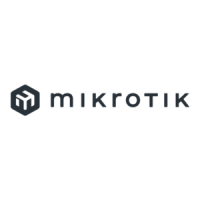• NTP - Network Time Protocol server and client; synchronization with GPS system
• Monitoring/Accounting - IP traffic accounting, firewall actions logging, statistics graphs
accessible via HTTP
• SNMP - read-only access
• M3P - MikroTik Packet Packer Protocol for Wireless links and Ethernet
• MNDP - MikroTik Neighbor Discovery Protocol; also supports Cisco Discovery Protocol
(CDP)
• Tools - ping; traceroute; bandwidth test; ping flood; telnet; SSH; packet sniffer; Dynamic DNS
update tool
TCP/IP protocol suite:
• Wireless - IEEE802.11a/b/g wireless client and access point (AP) modes; Nstreme and
Nstreme2 proprietary protocols; Wireless Distribution System (WDS) support; virtual AP; 40
and 104 bit WEP; WPA pre-shared key authentication; access control list; authentication with
RADIUS server; roaming (for wireless client); AP bridging
• Bridge - spanning tree protocol; multiple bridge interfaces; bridge firewalling, MAC NATting
• VLAN - IEEE802.1q Virtual LAN support on Ethernet and wireless links; multiple VLANs;
VLAN bridging
• Synchronous - V.35, V.24, E1/T1, X.21, DS3 (T3) media types; sync-PPP, Cisco HDLC,
Frame Relay line protocols; ANSI-617d (ANDI or annex D) and Q933a (CCITT or annex A)
Frame Relay LMI types
• Asynchronous - serial PPP dial-in / dial-out; PAP, CHAP, MSCHAPv1 and MSCHAPv2
authentication protocols; RADIUS authentication and accounting; onboard serial ports; modem
pool with up to 128 ports; dial on demand
• ISDN - ISDN dial-in / dial-out; PAP, CHAP, MSCHAPv1 and MSCHAPv2 authentication
protocols; RADIUS authentication and accounting; 128K bundle support; Cisco HDLC, x75i,
x75ui, x75bui line protocols; dial on demand
• SDSL - Single-line DSL support; line termination and network termination modes
Layer 2 connectivity
IA32 Hardware requirements
• CPU and motherboard - advanced 4th generation (core frequency 100MHz or more), 5th
generation (Intel Pentium, Cyrix 6X86, AMD K5 or comparable) or newer uniprocessor
(multi-processor systems are not supported) Intel IA-32 (i386) compatible architecture with PCI
local bus
• RAM - minimum 32 MiB, maximum 1 GiB; 64 MiB or more recommended
• Non-volatile storage medium - standard ATA/IDE interface controller and drive (SCSI and
USB controllers and drives are not supported; RAID controllers that require additional drivers
are not supported; SATA is only supported in legacy access mode) with minimum of 64 Mb
space; Flash and Microdrive devices may be connected using an adapted with ATA interface
MIPS Hardware requirements
• Supported systems - RouterBOARD 500 series (532, 512 and 511)
Page 2 of 695
Copyright 1999-2007, MikroTik. All rights reserved. Mikrotik, RouterOS and RouterBOARD are trademarks of Mikrotikls SIA.
Other trademarks and registred trademarks mentioned herein are properties of their respective owners.

